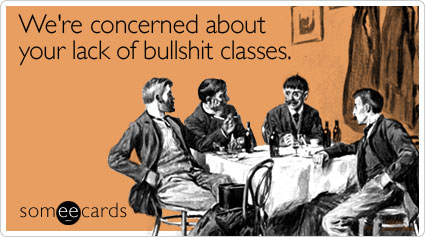Makeup Museum (MM) Musings is a series that examines a broad range of museum topics as they relate to the collecting of cosmetics, along with my vision for a "real", physical Makeup Museum. These posts help me think through how I'd run things if the Museum was an actual organization, as well as examine the ways it's currently functioning. I also hope that these posts make everyone see that the idea of a museum devoted to cosmetics isn't so crazy after all – it can be done!
 Today's installment of MM Musings is not actually about museums. (I know, I know – I should stick to the general purpose of this series. But this is a cool topic, I promise.) Instead, I want to talk about where beauty history and culture belongs in academia. I came across this post at one of my favorite fashion blogs, Worn Through, and it got my brain percolating on a beauty-focused academic curriculum. Obviously this is a challenge that fashion historians are still grappling with, so it will be equally tricky determining where beauty culture should go if courses in this area were offered. And I really hope they are some day, with me as the fearless founder and pioneer in the field.
Today's installment of MM Musings is not actually about museums. (I know, I know – I should stick to the general purpose of this series. But this is a cool topic, I promise.) Instead, I want to talk about where beauty history and culture belongs in academia. I came across this post at one of my favorite fashion blogs, Worn Through, and it got my brain percolating on a beauty-focused academic curriculum. Obviously this is a challenge that fashion historians are still grappling with, so it will be equally tricky determining where beauty culture should go if courses in this area were offered. And I really hope they are some day, with me as the fearless founder and pioneer in the field.
First we need to accept the premise that beauty culture and history are valid areas of study. Why? Any form of self-adornment, from tribal body piercings to lip gloss, speaks volumes about a particular culture – it's a unique window into the artistic, commercial, and social values of any group of people. Furthermore, I've already argued that some cosmetic items and beauty practices are a form of art and therefore belong in a museum, so it follows that they should be accepted as legitimate fields of study. I realize that's a rather simplistic way of saying beauty culture is important enough to warrant serious academic attention, but that's not what I wanted to tackle today. I want to focus on the admittedly more fun notion of actually being able to study and research all topics pertaining to beauty in a formal program. Many individuals have done scholarly work on beauty topics, but there is no one dedicated academic curriculum for them.
So if we accept the argument that beauty culture and history should be taught, that brings us to the main question: where does it belong? There are several possibilities. My first inclination is to assign topics pertaining to beauty and cosmetics to fashion history curricula. This would be a natural fit given the close relationship between beauty and fashion. However, since fashion studies itself is still struggling to figure out its proper place within academia, this may be problematic. The short (or long) answer is that like fashion studies, beauty culture and history encompass many disciplines. Therefore, just like fashion studies, they can find a home in a variety of fields.
Case in point: think of all the people who write about beauty and organize beauty-related exhibitions. They run the gamut from fashion curators and historians to feminist authors, from economists and business scholars to art historians and makeup artists. There are also collectors and other folks with a general interest in cosmetics. Due to the interdisciplinary nature of the study of beauty culture and history, it would fit in a variety of academic areas. The most obvious ones in my eyes are art history, general history, gender and women's studies, cultural studies, material culture, and anthropology. These would be ideal areas to host an individual program or track focused solely on beauty culture and history – sort of the way the Courtauld Institute in London has art history undergraduate and MA degrees with a specific "history of dress" track. Additionally, students in other fields could take individual courses in beauty culture to help round out their studies. For example, an art history major who wasn't signed up for the entire beauty culture track could take just one course in how ideal beauty is portrayed in art, from ancient Egyptian portraits of Nefertiti to Renaissance paintings to contemporary works. Design students could take a course in the history of cosmetics packaging design, and marketing majors could take a course examining the history of beauty advertising and where it's headed in the future. All of these classes would fall under the general umbrella of the beauty culture and history program, so students could be enrolled for that or take selected courses pertinent to their major.
What do you think? Would you attend a class or a whole program in beauty culture and history? I would, but I'm more interested in teaching…I have so many ideas for courses and could easily develop a whole curriculum. 😉
(image from someecards.com)

